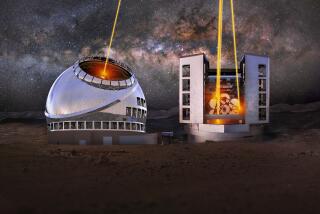Observatory Atop Mt. Wilson Aims to Rejoin Science
- Share via
WASHINGTON — After running the venerable Mt. Wilson Observatory in the mountains overlooking Los Angeles for 84 years, the Carnegie Institution Thursday formally handed over the facility that was once the world’s leading center of astronomy to a small Pasadena institute with an ambitious dream.
The Mount Wilson Institute, a nonprofit group headed by Arthur H. Vaughn, a veteran astronomer, is seeking several million dollars in private funds to expand research and restore the facility’s 100-inch reflecting telescope to active service.
In a small ceremony in Washington, Vaughn said that--despite the dazzling lights of Los Angeles a mile below the observatory and the occasional high-tide of smog that envelops the peak--Mt. Wilson is considered the finest site in the continental United States for observing the skies.
His plan, he said, is to put the observatory and its 100-inch telescope to work in a neglected area of astronomy--the study of closer, brighter stars to better understand the turbulent behavior of the sun and to search for other planetary systems.
“It is old, no doubt. But it forms very sharp images. That is what matters,” Vaughn noted. With modern computer processing of its images, he said, the telescope’s performance under some conditions could equal that of the billion-dollar Hubble Space Telescope that the space shuttle is scheduled to carry into Earth orbit in about a year.
The most promising sources of funds, Vaughn said, will be private corporations and possibly public subscriptions. In return, the Mount Wilson Institute proposes to make the observatory serve double duty as a regional astronomy education center.
Once the World’s Largest
The Mt. Wilson Observatory was established in 1904 with money from industrialist Andrew Carnegie. In July, 1917, a spindly truck wheezed up a perilous mountain road with a 100-inch mirror made of French wine-bottle glass, and four months later the world’s largest reflecting telescope--a distinction Mt. Wilson held for 31 years--was probing the universe.
With this telescope in the 1920s and ‘30s, astronomer Edwin P. Hubble discovered that what appeared to be nebulous wisps of glowing gas were in fact other galaxies, receding at unimaginable distances and speeds at the rim of an expanding universe.
Maxine F. Singer, president of the Carnegie Institution, said it was decided in 1984 to stop funding Mt. Wilson to divert money to construction of a mammoth new telescope in the Andes Mountains of Chile. The Magellan telescope’s mirror is to measure 315 inches, making it by far the world’s largest.
Meanwhile, Vaughn noted, reports of the demise of science on Mt. Wilson have been greatly exaggerated. “The public may think it’s closed, but it’s really a beehive of activity up there.”
Five research projects based at five universities are under way, financed by about $300,000 in federal grants, mostly from the National Science Foundation.
But the observatory no longer has funds for its own independent scientific staff. Vaughn said that he hopes to raise the operating budget to about $750,000 a year, but that another $1 million to $2 million will be needed to bring the 100-inch telescope out of mothballs.
“Before the National Science Foundation was there, astronomers knew how to raise money from private sources,” he said. “We’re going to have to learn that again.”






